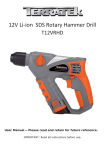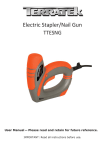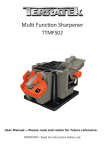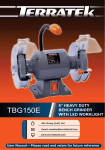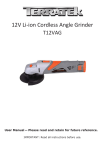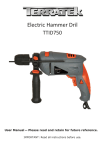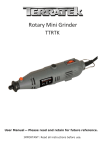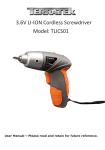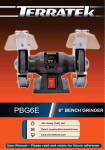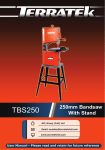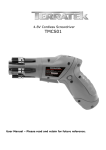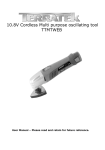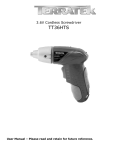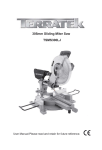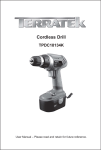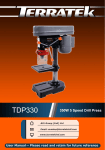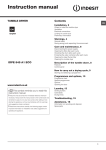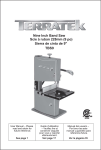Download TTMFS - User Manual
Transcript
DƵůƟ&ƵŶĐƟŽŶ^Ăǁ ddD&^ User Manual — Please read and retain for future reference. IMPORTANT: Read all instructions before use. Contents Parts List Technical Information Safety Instructions Using your tool Maintenance Warranty Parts List No. Description No. Description 1 Cable 38 Shaft circlip 2 Cable protector 39 Small gear 3 Screw ST3.9×16 40 Oil proof piece 4 Cable clamp 41 Bearing 609-2RS 5 Right housing 42 O shape seal22.4×1.8 6 Screw ST3.9×18 43 Bearing 626-2RS 7 Parameter label 44 Big gear 8 Compression spring 45 Worm 9 Self-locking pin 46 Bearing 628-2RS 10 Torsion spring 47 Oil proof piece 11 Screw M4×12 48 Circlip 24 12 Split washer 5 49 Shaft circlip 4 13 Slider 50 Reducer casing 14 Torsion spring 51 Compression spring 15 Lower guard trigger 52 Self-locking button 16 Trigger jacket 53 Screw M4×10 17 Compression spring 54 Bearing 627-2RS 18 self-locking cap for switch 55 Shaft circlip 19 Compression spring 56 Worm gear 20 Switch pushbutton 57 Steel jacket 21 Screw ST3.9×10 58 Reducer casing cover 22 Armature 59 Spring circlip 23 PCB Assembly 60 Screw M4×25 24 Stator 61 Output shaft 25 Tension spring 62 Clamping flange 26 Bearing 607-2RS 63 Dust guide cover 27 Brush holder support 64 Screw M4×8 28 Brush holder 65 Blade 29 Carbon brush 66 Outer flange 30 Carbon brush cover 67 hexagon-headed bolt M6×14-left 31 Right housing 68 nut M5 32 Nameplate 69 Lower guard left support 33 Torsion spring 70 Foot plate 34 Small steel bushing 71 Lower guard 35 Steel ball Л 2.5 72 Lower guard right support 36 Locking knob 73 Screw M5×60 37 Cam 74 Socket wrench 10mm 1 Exploded Assembly Diagram NOTICE: Actual product may vary from pictures shown. 2 3 1 2 6 5 9 7 4 10 Fig.1 11 8 7 10 Fig.2 1. ON/OFF switch 7. Locking device for the safety hood 2. Overload display 8. Spindle lock 3. Cutting depth limiter 9. Extraction hose 4. Guard hood 10. Carbon brush cap 5. Articulated axle of the guard hood 11. Saw blades 6. Housing 3 3 A B Fig.3 A Fig.2 Fig.4 4 Technical Information Model: TTMFS Rated Voltage: 230 – 240 V~ Rated Power: 500 W No-load Speed: 8000 /min Saw Blade: Ø 80 mm Cutting depth : Max. 20 mm Weight: 2.4 kgs 50Hz Read this entire manual before using this product. Failure to do so can result in serious injury. Save this manual for future reference. Copyright© 2013 by ACL Group (Intl) Ltd. All rights reserved. This manual or any artwork contained herein must not be reproduced in any shape or form without the express written consent of ACL Group (Intl) Ltd. Diagrams within this manual may not be drawn proportionally. Due to continuing improvements, actual product may differ slightly from the product described herein. 5 Read and Keep This Manual Please read carefully all instructions within this manual. Failure to follow all safety warnings can result in serious personal injury. The term “Power Tool” in all of the following warnings refers to your mains operated (corded) or battery operated (cordless) power tool. Important SAFETY Information This symbol is to warn you of potential personal injury hazards. Please read carefully the notes along side this warning to avoid possible injury or death. General Safety Rules WARNING! Read all instructions. Failure to follow all instructions listed below may result in electric shock, fire and/or serious injury. The term “power tool” in all of the warnings listed refers to corded or cordless power tools. Work area safety Keep work area clean and well lit. Cluttered or dark areas invite accidents. Do not operate power tools in explosive atmospheres, such as in the presence of flammable liquids, gases or dust. Power tools create sparks which may ignite the dust or fumes. Keep children and bystanders away while operating a power tool. Distractions can cause you to lose control. 6 Electrical safety Before use, ensure that the power outlet you are using matches the plug on your power tool and that the voltage of the outlet matches that of your power tool. Only use grounded extension cords with power tools fitted with 3 pin plugs and if using outdoors ensure any extension cord is suitable for outdoor use. Always try to avoid body contact with grounded surfaces, such as radiators, cooking ranges and any other fixed appliance with metal surfaces. Do not expose your power tool to wet or damp conditions and NEVER use in rain. Check regularly the power cord of your machine and any extension cord that you are using for damage. Do not carry or pull the machine with the power cord. Ensure the cord is clear from hot surfaces, oil or sharp objects. Personal safety Never use your power tool whilst under the influence of alcohol, drugs or medication. Tiredness can often cause accidents, stay alert. Never use your power tool without the correct guards in place. Always use approved eye protection and dust mask. Non slip safety shoes and hearing protectors should be worn at all times when using your power tool. Ensure any dust collecting device supplied with your machine is connected correctly before use. Ensure all loose clothing, long hair or jewelry is kept clear of the machine. Before plugging your power tool into the power outlet ensure the power tool is in the OFF position. Check that wrenches or adjusting keys have been removed. Any wrench or key left attached to a moving part can result in injury. Power tool use and care. Keep your power tool clean and well serviced at all times. Never adjust or service any power tool before disconnecting from the mains electricity supply. Always use the correct tool for the job. Never force the tool to work harder than it is designed to do. Never use your power tool with broken parts such as switches, guide fences or leg stands. ALWAYS keep your power tools away from children. Keep cutting tools sharp to ensure less stress on the motor. Only have your power tool serviced by a qualified repair agent using manufacturers recommended parts. 7 Service Have your power tool serviced by a qualified repair person using only identical replacement parts. This will ensure that the safety of the power tool is maintained. Develop a periodic maintenance schedule for your tool. When cleaning a tool be careful not to disassemble any portion of the tool since internal wires may be misplaced or pinched or safety guard return springs may be improperly mounted. Certain cleaning agents such as gasoline, carbon tetrachloride, ammonia, etc. may damage plastic parts. When servicing a tool, use only identical replacement parts. Follow instructions in the Maintenance section of this manual. Use of unauthorized parts or failure to follow Maintenance Instructions may create a risk of electric shock or injury. WARNING: For your own safety read Instruction Manual before operating your power tool. A) Wear eye protection. B) Keep hands out of the path of cutting tools. C) Do not operate tool without guards in place. D) Do not perform any operation freehand. E) Never reach around cutting tools. F) Turn off tool and wait for cutting tools to stop before moving work piece or changing settings. G) Disconnect power (or unplug tool) before changing cutting tools or servicing. GENERAL SAFETY INSTRUCTIONS Read this owner's manual completely and make sure you understand all of its safety guidelines. 1. KEEP GUARDS IN PLACE and in working order. 2. REMOVE ADJUSTING KEYS & WRENCHES. Before turning on the power tool, make sure the keys and adjusting wrenches have been removed. 3. KEEP WORK AREA CLEAN. Cluttered areas and benches invite accidents. 4. ALWAYS REMAIN ALERT WHEN THE TOOL IS IN USE. Inattention on the part of the operator may lead to serious injury. 5. DON’T USE IN A DANGEROUS ENVIRONMENT. Don’t use power tools in damp or wet locations or expose them to rain. Keep work area well lit. 6. KEEP CHILDREN AWAY. All visitors should remain at a safe distance from work area. 7. MAKE WORKSHOP CHILD-PROOF with padlocks, master switches or by removing starter keys. 8. USE THE RIGHT TOOL. Don’t force a tool or attachment to do a job for which it was not designed. 8 9. USE THE PROPER EXTENSION CORD. Make sure your extension cord is in good condition. When using an extension cord, be sure to use one heavy enough to carry the current your product will draw. An undersized cord will cause a drop in line voltage resulting in loss of power and overheating. If in doubt, use the next heavier gauge. The smaller the gauge number, the heavier the cord. 10. DON’T FORCE THE TOOL. It has been designed to operate at maximum safety and performance levels. 11. DO NOT FORCE THE MATERIAL BEING CUT. Always let the tool cut at its own speed. 12. WEAR PROPER APPAREL. Do not wear loose clothing, neckties, rings, bracelets or other jewelry which may get caught in moving parts. Non-slip foot wear is recommended. Wear protective hair covering if you have long hair. 13. ALWAYS USE SAFETY GLASSES. Also use face or dust mask for commercial cutting operations. Everyday eyeglasses only have impact-resistant lenses, they are NOT safety glasses. 14. SECURE WORK. Use clamps or a vise instead of your hand to hold work when practical. This safetyprecaution allows for proper tool operation using both hands. 15. DON’T OVERREACH. Keep proper footing and balance at all times. 16. MAINTAIN TOOLS WITH CARE. Keep tools clean and in good working condition for maximum safety performance. Follow instructions for lubricating and changing accessories. 17. DISCONNECT TOOLS BEFORE SERVICING – when changing accessories, such as blades, bits, cutters, etc. 18. REDUCE THE RISK OF UNINTENTIONAL STARTING. Make sure switch is in OFF position before plugging in. 19. USE RECOMMENDED ACCESSORIES. Consult the owner’s manual for recommended accessories. The use of improper accessories may increase risk of injury. 20. MAKE SURE YOU USE THE CORRECT TOOL for the job you are doing. 21. NEVER STAND ON TOOL. Serious injury could occur if the tool is tipped or if the cutting tool is unintentionally contacted. 22. CHECK DAMAGED PARTS. Before further use of the tool, damaged part(s), (i.e., guard) should be carefully checked to determine that it will operate properly and perform its intended function. Check for alignment of moving parts, binding of moving parts, breakage of parts, mounting and any other condition that may affect the tools operation. A guard or other part that is damaged should be properly repaired or replaced. 23. Replace damaged blades/cutters immediately. DO NOT USE DAMAGED BLADES/ CUTTERS. They may cause bodily injury. 24. DIRECTION OF FEED. Feed work into the blade/cutter against the direction of rotation of the blade/cutter only. 25. DO NOT ALTER THE PLUG. 9 26. NEVER LEAVE TOOL RUNNING UNATTENDED. Turn power off. Don’t leave tool until it comes to a complete stop. 27. Double Insulation eliminates the need for the three wire grounded power cord and grounded power supply system. This power tool is supplied with all the relevant safety guards and features, it should be checked before every operation, this manual should be read and kept in a safe place. Whilst we warn of all the possible risks attached to using power tools any operator must have read and understood the manual and apply their own caution and common sense when using this power tool. Following this guide will greatly reduce your risk of electric shock or injury. Only use qualified repair agents to service this power tool. Only use qualified electrician to repair any damaged wiring. NEVER remove the grounding prong from the power tool or extension cord. ĚĚŝƟŽŶĂůƐĂĨĞƚLJ/ŶƐƚƌƵĐƟŽŶƐ Multi Function Saw Danger: a) Do not reach into the cutting area or touch the saw blade. Hold the additional handle or the motor casing with your other hand. If you hold the circular saw in both hands, the saw blade cannot injure them. b) Do not reach under the workpiece. The guard hood cannot protect you from the saw blade under the workpiece. c) Adjust the cutting depth to the thickness of the workpiece. Less than one full tooth height should be visible under the workpiece. d) Never hold the workpiece you wish to saw in your hand or on your leg. Secure the workpiece on a sturdy surface. It is important that you secure the workpiece well to minimize the danger of body contact, the saw blade jamming or loss of control. 10 e) Hold the tool only by the insulated handles when carrying out work during which the cutting tool could strike concealed power cables or its own cable. Contact with a live cable will also make the metal parts of the appliance live and will cause an electric shock. f) Always use a stop or a straight edge when carrying out longitudinal cuts. This will improve your cutting accuracy and reduce the possibility of the saw blade jamming. g) Always use saw blades of the correct size and with a suitable mounting hole (diamondshaped or round). Saw blades that do not match the mounting parts of the saw will not rotate truly and will result in a loss of control. h) Never use damaged or incorrect saw blade washers or screws. The saw blade washers and screws have been specially designed for your saw to ensure perfect performance and operational safety. Additional safety instructions for all saws Causes of and ways to avoid recoil: 1. Recoil is the sudden reaction resulting from a caught, jammed or incorrectly aligned saw blade which may result in the saw leaping out of the workpiece out of control and towards the operator. 2. If the saw blade becomes caught or jammed in closing saw gap, it will lock and the power of the motor will cause the saw to leap backwards towards the operator. 3. If the saw blade is twisted or incorrectly aligned in the cut, the teeth in the rear saw blade edge may become caught in the surface of the workpiece, which results in the saw blade leaping out of the saw gap and the saw leaping towards the operator. A recoil is the result of incorrect or wrong use of the saw. It can be prevented by suitable precautions, as described below. a) Hold the saw firmly in both hands and hold your arms in a position in which you can withstand the recoil forces. Always hold the saw blade to one side. Never hold the saw blade in a straight line with your body. In the event of a recoil the circular saw may leap backwards, but the user can still overcome the recoil forces if he has taken suitable precautions. b) If the saw blade jams or the sawing operating is interrupted for another reason, release the ON/OFF switch and hold the saw steady in the workpiece until the saw blade has reached a complete stop. Never attempt to take the saw out of the workpiece or to pull it backwards whilst the saw blade is moving or there is a possibility of a recoil. Find the reason for the blade jamming and rectify it by suitable means. 11 c) If you wish to restart a saw that is already in the workpiece, center the saw blade in the saw gap and check that the saw’s teeth are not caught in the workpiece. If the saw blade is jammed it may move out of the workpiece or cause a recoil when the saw is restarted. d) Support large panels to reduce the risk of a recoil by a jammed saw blade. Large panels may sag under their own weight. Panels must be supported on both sides both near the saw gap and also at the edge. e) Do not use blunt or damaged saw blades. Saw blades with blunt or incorrectly aligned teeth will create increased friction due to the saw gap being too small. In addition the saw blade may also jam and cause recoil. f) Secure the cutting depth and cutting angle settings before starting to saw. If the settings change as you are sawing, the saw blade may jam and cause recoil. g) Be particularly careful when carrying out a “plunge cut” in a concealed area such as an existing wall. The plunge-cutting saw blade may block when sawing into concealed objects and thus cause recoil. Safety instructions for saws with a swing guard hood a) Check that the bottom safety hood closes perfectly before using the appliance. Do not use the saw if the bottom safety hood does not move freely and does not close immediately. Never clamp or tie the bottom guard hood in open position. If you drop the saw by accident the bottom guard hood may become bent. Open the safety hood with the lever and ensure that it moves freely and will not come into contact with the saw blade or other parts regardless of the cutting angle and depth. b) Check the function of the spring on the bottom safety hood. Have the appliance serviced before you use it if the bottom safety hood and spring are not in perfect working order. Damaged parts, sticky deposits or accumulations of chips will result in the bottom guard hood working with a delay. c) Open the bottom safety hood by hand only for special cuts, such as “immersion and angle cuts”. Open the bottom safety hood using the lever and release the lever again as soon as the saw blade has engaged in the workpiece. The bottom safety hood must operate automatically for all other sawing work. d) Do not place the saw on a workbench or on the floor unless the bottom guard hood is covering the blade. An unprotected, moving saw blade will cause the saw to move opposite to the sawing direction and saw through anything in its way. Remember that the saw takes a little time to slow down and stop. 12 Wear hearing protection. Exposure to noise can cause hearing loss. Always wear eye protection. Use appropriate detectors to determine if utility lines are hidden in the work area or call the local utility company for assistance. Contact with electric lines can lead to fire and electric shock. Damaging a gas line can lead to explosion. Cutting into a water line causes property damage or may cause an electric shock. Switch off the power tool immediately if the tool insert jams. Be prepared for high reaction torque that can cause kickback. The tool insert jams when:the power tool is subject to overload.it becomes wedged in the workpiece. Hold power tool by the insulated gripping surfaces, when performing an operation where the cutting tool may run into hidden wiring. Contact with a “live” wire will make exposed metal parts of the tool “live” and shock the operator. When working with the machine, always hold it firmly with both hands and provide for a secure stance. The power tool is guided more secure with both hands. Keep your workplace clean. Blends of materials are particularly dangerous. Dust from light alloys can burn or explode. Always wait until the machine has come to a complete stop before placing it down. The tool insert can jam and lead to loss of control over the power tool. Before any work on the machine (e. g., maintenance, tool change, etc.) as well as during transport and storage, set the rotational direction switch to the centre position. Unintentional actuation of the On/Off switch can lead to injuries. Avoid unintentional switching on. Ensure the On/Off switch is in the off position before plugging to outlet. Carrying the power tool with your finger on the On/Off switch that have the switch on invites accidents. Protect the power tool against heat, e. g., also against continuous sun irradiation and fire. Check any parts concerned. Clean such parts or replace them, if required. Power Extension Cords When using any extension cord the machine will suffer a power reduction due to the drop in voltage caused by the length of the cord. This can be partially offset by selecting extension cords with lower gauge wire. Check all extension cords for damage before use. Avoid sharp objects. Do not position the cord where it could be subject to traffic passing over it 13 Symbols IMPORTANT: Some of the following symbols may be used on your tool. V…………………………volts A…………………………amperes Hz……………………….hertz ~…………………….….alternating current …/m……………….....revolutions per minute .....................class II construction (double insulated) Kg………………………..kilograms n0………………………..No load speed ……………….….....Conforms to European Harmonised New Approach Directives. DC ………………..…….Direct Current Specific Safety Rules 1) Hold power tools by insulated gripping surfaces when performing an operation where the cutting tool may contact hidden wiring. Contact with a “live” wire will make exposed metal parts of the tool “live” and shock the operator. 2) Wear ear and eye protection. To avoid serious injuries. 3) If the cutter becomes jammed, immediately turn the trigger switch off to prevent an overload which can damage the battery pack or motor. Use reverse to loosen jammed bits. 4) Do not touch the rotating parts to avoid injury. 5) Do not use the tool continuously for a long period of time. Stop using the tool from time to time to avoid overheating of the motor. 6) Do not drop the tool. Unpacking Carefully remove the product and any accessories from the box. Make sure that all items listed in the packing list are included. Package contents A) Multi function saw B) User manual C) 1 diamond blade for cutting tiles, 1 TCT blade for wood-based materials and plastic and 1 HSS blade for metal 14 Before starting the equipment Before you connect the equipment to the mains supply make sure that the data on the rating plate are identical to the mains data. Always pull the power plug before making adjustments to the equipment. Setting the cutting depth (Fig.3) 1.Undo the setting screw (3). 2.Set the cutting depth in accordance with the scale (a). 3.When cutting wood or plastic the selected cutting depth should be a little larger than the material thickness. 4.To prevent damage to underlying surfaces, the cutting depth can be set exactly to the thickness of the material. However, this will result in a slightly unclean cut. Operation Working with the mXOWL function saw 1. Always hold the mXOWL function saw firmly. 2. Do not use force! Push forwards gently and evenly with the mXOWL function saw. 3. The waste piece should be on the right-hand side of the mXOWL function saw so that the wide section of the support bench supports its full area. 4. If you are sawing down a line that has been drawn, guide the mXOWL function saw along t he corresponding notch. 5. Clamp small pieces of wood securely before sawing them. Never hold them with your hand. 6. Always follow the safety instructions. Wear safety goggles. 7. Do not use defective saw blades or blades that are cracked or broken. 8. Do not use any flanges / flange nuts whose bore hole is larger or smaller than those in the saw blade. 9. The saw blade must not be decelerated by hand or by applying lateral pressure to the blade. 10. The guard hood must not jam and must return to its initial position after the operation has been completed. 11. Before you use the mXOWL function saw, check the function of the guard hood with the mains plug disconnected. 12. Before you use the machine, ensure that the safety equipment such as the guard hood, flanges and adjustment devices are in working order and are correctly adjusted and secure. 13. You can connect a suitable dust extraction system to the sawdust extraction connector (9). Ensure that the dust extractor line is safely and correctly connected. Warning! Always pull out the power plug before doing any work on the circular saw! 15 Using the multi function saw 1. Select a suitable blade for the material you wish to saw. 2. Check the condition and sharpness of the blade. 3. Set the cutting depth. 4. Pick up the tool and make sure that no air vents are covered. 5. Switch on the tool and wait for a few seconds for the blade to reach operating speed. 6. Press the locking button (7) and, applying a little pressure, slowly lower the tool into the workpiece. If the overload display (2) lights up, reduce the speed. 7. Push the saw forwards through the workpiece. Never cut backwards! 8. If the overload display (2) lights up, reduce the speed. If the tool stops and the overload display (2) lights up continuously, the overload cut-out has triggered. Reasons: The feed speed was too high or there is an obstruction in the workpiece. In this case, switch off the tool and check the workpiece. Continue at a reduced feed speed. Warning! Exert only little pressure on the tool when cutting. The base plate must always lie flat on the workpiece. Switching ON/OFF (Fig. 1) To switch on: Turn on the device by pressing and sliding the switch (1). Then press the safety lock. To switch off: Release the switch (1). Warning! Carry out a trial cut in a piece of waste wood Changing the saw blade Warning! Always pull out the power plug before doing any work on the circular saw! Only use saw blades of the same type as the saw blade supplied with this circular saw. Ask your dealer for advice. Warning! The mXOWL function saw must not be operated with the Socket wrench inserted in it. 1. Press the spindle lock (Fig.2-8). 2. Undo the screw to secure the saw blade (Fig.3-B) using the Socket wrench and turning clockwise. 3. Press the locking device for the safety hood (Fig.2-7), push back the hinged guard hood and hold firmly. 4. Remove the saw blade (Fig.1-11) in a downwards direction. 16 5. Clean the flange and insert the new saw blade. Pay attention to the running direction (see arrow on the housing and saw blade). 6. Tighten the screw to secure the saw blade (11) and check that it runs true. 7. Before you press the On/Off switch, make sure that the saw blade is correctly fitted and that moving parts run smoothly and the clamping screws are tightened securely. Overload cut-out (Fig.1) The device is fitted with an overload cut-out. The overload display (2) indicates the tools operating status. The overload display (2) flashes: The tool is reaching its load limit – reduce the feed speed. The overload display (2) lights up continuously: The tool is overloaded or blocked – the tool shuts down. In this case, switch off and restart. Line cuts You can easily follow a drawn line with the help of the indicators (Fig.4-A), which are fitted to the guard hood at the front. Replacing the power cable If the power cable for this equipment is damaged, it must be replaced by the manufacturer or its aftersales service or similarly trained personnel to avoid danger. Carbon brushes In case of excessive sparking, have the carbon brushes checked only by a qualified electrician. Important! The carbon brushes should not be replaced by anyone but a qualified electrician. 17 Disposal Power tools, accessories and packaging should be sorted for environmentally-friendly recycling. Only for EC countries: Do not dispose of power tools into household waste! According to the European Directive 2002/96/EC on waste electrical and electronic equipment and its incorporation into national right, products that are no longer suitable for use must beseparately collected and sent for recovery in an environmentally-friendly manner. Maintenance 1. Keep all safety devices, air vents and the motor housing free of dirt and dust as far as possible. Wipe the equipment with a clean cloth or blow it with compressed air at low pressure. 2. We recommend that you clean the device immediately each time you have finished using it. 3. Clean the equipment regularly with a moist cloth and some soft soap. Do not use cleaning agents or solvents; these could attack the plastic parts of the equipment. Ensure that no water can seep into the device. Accessories CAUTION: Use only accessories or attachments recommended for use with your Terratek tool specified in this manual. The use of any other accessories or attachments might present a risk of injury to persons. Only use accessory or attachment for its stated purpose. General Maintenance 1. Keep the air vents free from obstruction and clean regularly. 2. Check regularly for any dust particles entering the grills around the motor and the switch. Use a soft brush to remove any dust particles. Wear safety glasses to protect your eyes whilst cleaning. 3. Monitor the dust bag (if equipped) and empty when approximately half full. Always empty into an appropriate container. REMEMBER: dust can be hot and cause fire. 4. If the cutting tool has become dull, replace it. Dull cutters will cause increased tear-out and ragged edges on the cuts. 5. Lubricate all moving parts at regular intervals. 6. To clean the body of the power tool, only use a soft damp cloth. Do NOT immerse in water. A mild detergent can be used but NOT petrol or any alcohol based product. 7. Should the power cord become damaged only allow a fully qualified electrician to replace or repair. 18 ĞĐůĂƌĂƟŽŶŽĨŽŶĨŽƌŵŝƚLJ We ACL Group (Intl.) Ltd, England DN6 8LZ declare that the Multi Function Saw l has been manufactured according to our full quality assurance procedures. The declaration is to certify that it conforms to CE, EMC, MD and RoHS directives: EN55014-1/A2:2011 EN55014-2/A2:2008 EN61000-3-2/A2: 2009 EN61000-3-3: 2008 All provisions of Annex 1 of Council Directive 2004/108/EC – EMC directive EN60745-1: 2009 EN ISO 12100-2/A1: 2009 All provisions of Annex 1 of Council Directive 2006/42/EC – Machinery Directive 2006/95/EC – Low Voltage Directive RoHs 2011/65/EU 2011/65/EU Mr. Alan Garnett, UK QA Manager 19 Environmental Protection RECYCLING: WASTE ELECTRICAL PRODUCTS SHOULD NOT BE DISPOSED OF WITH HOUSEHOLD WASTE. PLEASE RECYCLE WHERE FACILITIES EXIST. CHECK WITH YOUR LOCAL AUTHORITY OR RETAILER FOR RECYCLING ADVICE. Please read the following carefully ACL Group (Intl) Ltd. and/or it’s distributor has provided the parts list and assembly diagram as a reference tool only. Neither ACL Group (Intl). Ltd. or its distributor makes any representation or warranty of any kind to the buyer that he or she is qualified to do any repairs or replace any parts of this product. ACL Group (Intl) Ltd. and its distributor expressly state that all repairs or parts replacement should be done by certified or licensed technicians. The buyer assumes all risk and liability arising out of his or her repairs or parts replacement to the original product. 12 Months Limited Warranty If within 12 months from the date of purchase you experience any problems with your product, please return the product to its distributor/dealer for repair or replacement. This warranty DOES NOT COVER normal wear, or any damage as a result of accidents, misuse, abuse or negligence. ACL Group (Intl) Ltd Doncaster, England Email: [email protected] www.terratekintl.com 20





















